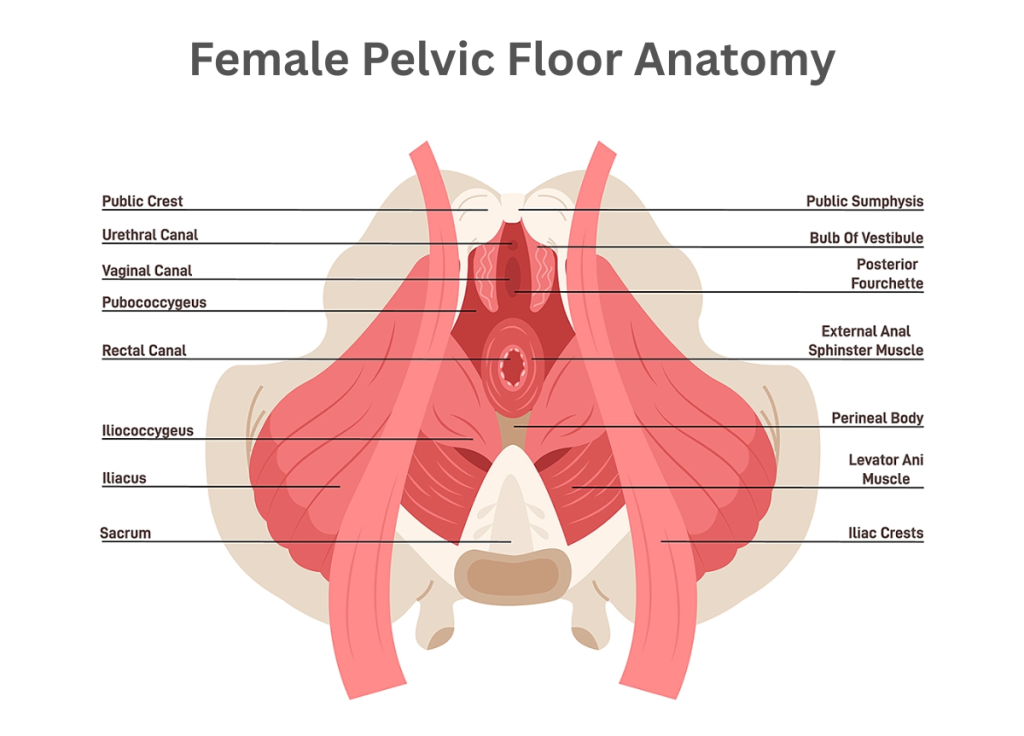Resources
- Finding Relief from Pain During Sex: Pelvic Floor Exercises That Work
- The Connection Between Exercise and Bloating: What Every Professional (and Their Clients) Need to Know
- How to Strengthen Pelvic Floor Safely
- Pelvic Floor Exercises for Constipation: Awareness, Movement, and Nervous System Relief
- How Menopause Affects the Pelvic Floor: Symptoms, Support & Hormonal Impact
- Tailbone Wagging for Tailbone Pain Relief and Pelvic Floor Mobility
- The Power of Tremoring: How Tension Release Exercises Support Your Nervous System
- Pelvic Floor Postpartum Exercises for Faster Recovery
- Navigating Coccyx Pain in Pregnancy: A Trimester-by-Trimester Guide
- Understanding Coccyx Pain: Symptoms, Causes, Healing and Prevention
- Pilates and Pelvic Floor Dysfunction: Is It the Solution You’re Seeking?
- 5 Pilates Pelvic Floor Exercises You Don’t Want to Leave Out
- Pelvic Floor Massage: A Comprehensive Guide
- Does Pilates Strengthen Pelvic Floor Muscles? A Comprehensive Guide
- Hypermobility and Pelvic Floor Health: What You Need to Know
- The Foot to Pelvic Floor Connection: A Whole-Body Approach to Movement and Health
- Understanding Pelvic Floor Pain After Running: Causes and Solutions for Professionals
- Top 5 Exercises to Strengthen the Pelvic Floor
- Do Squats Strengthen Pelvic Floor Muscles? Insights for Movement Professionals
- How Pelvic Floor Health Is Related to the Process of Moving from Arousal to Orgasm
- 5 Things I Wish People Knew About Your Pelvic Floor & Orgasm
- Pelvic Floor Tension: Everything You Need to Know
- How Running and Pelvic Floor Health Are Interconnected: What Every Runner Should Know
- Does Running Strengthen Pelvic Floor Muscles? Myths vs. Facts
- Understanding Urine Leakage Causes: Why It Happens and How to Manage It
- How to Strengthen Your Pelvic Floor: The Ultimate Guide
- Strengthening and Restorative Yoga Poses for Full Body Health
- Understanding Queefing: Causes, Symptoms, and Simple Prevention Tips
- How Do You Know if You Have a Weak Pelvic Floor
- What Does Pelvic Floor Pain Feel Like?
- How Can I Strengthen My Pelvic Floor Without Kegels?
- Pelvic Floor Stretches | 5 Quick Ways To Relax Your Pelvis
- Pelvic Floor Specialist | Finding Help To Heal Your Pelvis
- Is Pelvic Floor Repair Major Surgery? | Pelvic Health Guide
- Pelvic Floor Exercise
- How to Strengthen Pelvic Floor
- Pelvic Floor Therapy | Improving Your Pelvic Health
Resources
- Finding Relief from Pain During Sex: Pelvic Floor Exercises That Work
- The Connection Between Exercise and Bloating: What Every Professional (and Their Clients) Need to Know
- How to Strengthen Pelvic Floor Safely
- Pelvic Floor Exercises for Constipation: Awareness, Movement, and Nervous System Relief
- How Menopause Affects the Pelvic Floor: Symptoms, Support & Hormonal Impact
- Tailbone Wagging for Tailbone Pain Relief and Pelvic Floor Mobility
- The Power of Tremoring: How Tension Release Exercises Support Your Nervous System
- Pelvic Floor Postpartum Exercises for Faster Recovery
- Navigating Coccyx Pain in Pregnancy: A Trimester-by-Trimester Guide
- Understanding Coccyx Pain: Symptoms, Causes, Healing and Prevention
- Pilates and Pelvic Floor Dysfunction: Is It the Solution You’re Seeking?
- 5 Pilates Pelvic Floor Exercises You Don’t Want to Leave Out
- Pelvic Floor Massage: A Comprehensive Guide
- Does Pilates Strengthen Pelvic Floor Muscles? A Comprehensive Guide
- Hypermobility and Pelvic Floor Health: What You Need to Know
- The Foot to Pelvic Floor Connection: A Whole-Body Approach to Movement and Health
- Understanding Pelvic Floor Pain After Running: Causes and Solutions for Professionals
- Top 5 Exercises to Strengthen the Pelvic Floor
- Do Squats Strengthen Pelvic Floor Muscles? Insights for Movement Professionals
- How Pelvic Floor Health Is Related to the Process of Moving from Arousal to Orgasm
- 5 Things I Wish People Knew About Your Pelvic Floor & Orgasm
- Pelvic Floor Tension: Everything You Need to Know
- How Running and Pelvic Floor Health Are Interconnected: What Every Runner Should Know
- Does Running Strengthen Pelvic Floor Muscles? Myths vs. Facts
- Understanding Urine Leakage Causes: Why It Happens and How to Manage It
- How to Strengthen Your Pelvic Floor: The Ultimate Guide
- Strengthening and Restorative Yoga Poses for Full Body Health
- Understanding Queefing: Causes, Symptoms, and Simple Prevention Tips
- How Do You Know if You Have a Weak Pelvic Floor
- What Does Pelvic Floor Pain Feel Like?
- How Can I Strengthen My Pelvic Floor Without Kegels?
- Pelvic Floor Stretches | 5 Quick Ways To Relax Your Pelvis
- Pelvic Floor Specialist | Finding Help To Heal Your Pelvis
- Is Pelvic Floor Repair Major Surgery? | Pelvic Health Guide
- Pelvic Floor Exercise
- How to Strengthen Pelvic Floor
- Pelvic Floor Therapy | Improving Your Pelvic Health
High-Tone Pelvic Floor Dysfunction: Symptoms, Causes & Relief Tips
By Maressa Fonger McKee 06/30/2025
4 Min Read
Excess tension in the pelvic floor is considered ‘high-tone pelvic floor dysfunction’. It is a very common issue that we see contributing to pelvic floor discomfort and a variety of symptoms. Thankfully, you can find relief. In this article, we will discuss the basic anatomy of your pelvic floor, what you may experience as symptoms, the potential causes for these symptoms and ways you can find relief.
Table of Contents
Understanding Your Pelvic Floor: Anatomy, Importance & Risk Factors
Your pelvic floor is composed of many bands of muscle that span across the bottom opening of your pelvis. These muscles are suspended ‘hammock-like’ front to back between your pubic bone and tailbone, and side to side between your sit bones, which makes your pelvic floor a diaphragm! Just like your breathing diaphragm, your pelvic floor is meant to raise and lower – contract and release as needed – to function optimally. Your elimination pathways and sexual organs, i.e your urethra, rectum, penis and/or vaginal canal, are a part of and pass through openings in your pelvic floor.
High-tone pelvic floor dysfunction (also referred to as hypertonic pelvic floor) can restrict these pathways, around your pelvic organs and surrounding tissues. This can impact how they function and create or contribute to symptoms that can take hold of your daily life, keeping you from activities you love. This is why pelvic floor health is so important; the pelvic floor isn’t isolated from everything else in your body. The quality and tone of your pelvic floor tissue greatly impact your body as a whole, and consistent discomfort affects mental / emotional health as well.
Hypertonic pelvic floor is, unfortunately, often misdiagnosed or misunderstood as a huge contributing factor to a variety of symptoms that we will discuss in this article. Often, this is because the role of soft tissue imbalances in symptom presentation is largely overlooked. Anyone is at risk for dysfunction from a chronically tense pelvic floor, but especially those with pelvic organ prolapse, high stress or sedentary lifestyles, poor posture and weak core muscles. Those who have given birth, are going through hormonal changes or have experienced trauma are also at risk. No matter where you are in your pelvic floor wellness journey, building greater awareness around the state of your pelvic floor is essential for noticing potential patterns, such as high-tone pelvic floor dysfunction, so you can address them before symptoms manifest or get worse. (1)

What Is High-Tone Pelvic Floor Dysfunction?
When muscles become excessively tense, they are called ‘high-tone’. Tone refers to the level of tension a muscle has at rest. This becomes a pattern of dysfunction or imbalance when tension is chronic, excessive, and the muscles are unable to release it. They can be experienced or described as ‘stuck’ in a contracted state, ‘held’ or ‘clenched’. This excess tension, if left untreated, can affect surrounding tissues and become a source of pain and discomfort.
What Causes a Chronically Tense Pelvic Floor?
1. Weakness & Imbalance in Surrounding Muscles
So, how does musculature like the pelvic floor become excessively tense, potentially leading to high-tone pelvic floor dysfunction? Excessive, chronic tension can be caused by weakness in surrounding tissues, potential posture or alignment issues, lifestyle choices, nervous system dysregulation from chronic stress or pain and overall overuse of the muscles beyond their capacity to handle what you task them with.
As stated earlier, the pelvic floor isn’t isolated. It is connected by bones, ligaments and fascia to surrounding muscles and even parts of the body you may think are totally unrelated, like the feet or jaw! If there is weakness or excess tension in surrounding areas, the pelvic floor often responds by gripping to make up for other muscles’ inability to share in the work. This is especially true if the core, glutes and hip flexors are overly tense and /or weak. The pelvic floor can end up bearing the brunt, leading to strain, clenching and high-tone pelvic floor dysfunction.
2. Posture & Alignment Issues
This imbalance of strength and functioning in the pelvic floor and surrounding tissues tends to go hand in hand with posture or alignment issues and lifestyle choices. Your body is incredible in its ability to adapt. It follows your lead and will adjust itself to meet the demands you ask of it most often. A largely sedentary lifestyle, for instance, leads to a weak core, glutes and hip flexors because those muscles aren’t being tasked adequately. The act of constant sitting can also cause the tailbone to become excessively tucked under, effectively shortening the length of the pelvic floor, contributing to contracted musculature. Therefore, exercises that help to strengthen and lengthen these areas can go a long way towards helping the pelvic floor re-pattern itself out of dysfunction. We will get into some examples of these exercises for high-tone pelvic floor dysfunction later on in this article.
3. Overuse & Guarding Patterns
A pattern of holding in urination or bowel movements, or tensing the pelvic floor to try and mitigate the feeling of tissue ‘falling down’ that can come with pelvic organ prolapse, are other ways the pelvic floor can become excessively tense. This is an example of overuse of the muscles beyond their capacity to handle load.
4. Nervous-System Dysregulation & Stress Response
Perhaps one of the biggest contributing factors to dysfunction from hyper-tonic pelvic floor is chronic stress, chronic pain, trauma and injury. Chronic stress and pain are largely driven by the state of your nervous system. If you are hypervigilant to potential external dangers or are chronically stressed and in fight, flight or freeze, your soft tissues, especially the pelvic floor, tighten to brace against the perceived stressor or to be able to react or flee at a moment’s notice. This is a basic survival instinct. This ‘bracing’ and tightening is also often a response to chronic pain and discomfort associated with other conditions, such as endometriosis or PMDD (Premenstrual Dysphoric Disorder). Scar tissue from tearing during birth or abdominal surgery, such as a C-section, can also affect the pelvic floor, creating tension and even tightening as a protective response. (2)
Symptoms of Pelvic Floor Dysfunction
Now, let’s get into what you may experience as high-tone pelvic floor dysfunction symptoms and what to watch for:
- Chronic pelvic pain or sense of fullness
- Pins and needles or loss of sensation in the groin / penis / vulva
- Painful intercourse or pain after orgasm
- Lower back, hip and lower abdominal discomfort or tension
- Constipation
- Incomplete emptying of the bladder/bowels
- Delayed or slow urine stream
- Painful (burning) urination
- Vaginismus
- Urinary urgency / frequency
- Tailbone pain
- Urinary stress incontinence (when jumping, sneezing, etc)
- Pain while sitting or standing for extended periods of time (2)
Say you experience one or more of these symptoms, now what? Luckily, there are many tools you can use – both at home and with a professional – to help you find relief.
High-Tone Pelvic Floor Dysfunction Treatments: Finding Relief
Before getting into what you can do to help mitigate discomfort, let’s first talk about one of the most widely prescribed pelvic floor exercises: Kegels.
Kegels are an exercise intended to strengthen the pelvic floor by contracting the muscles of the vaginal canal or perineal area. When it comes to high-tone pelvic floor dysfunction, however, Kegels can often make symptoms worse. This is because, with a hypertonic pelvic floor, the muscles are already in a contracted state. Instead of adding excess tone through contractions, we need to focus on exercises and treatments that allow the pelvic floor to lengthen and release while we work to strengthen surrounding muscles and prioritize proper pelvic alignment.
Professional Interventions:
It can be really helpful to begin treatment with a professional who can get you started in the right direction. Some examples of professional interventions include a pelvic floor physical therapist, a massage or myofascial release practitioner, a licensed acupuncturist, biofeedback therapy, the RYC® Program, or working with a certified RYC® Teacher.
A pelvic floor physical therapist can help diagnose high-tone pelvic floor dysfunction so you can be sure that is what you are dealing with regarding your symptoms. They are trained to use internal and external methods to do so. They can then offer you specific exercises based on their findings.
A massage or myofascial release practitioner can use manual manipulation of the soft tissue of your abdomen, hips, glutes, pubic area, thighs and hip flexors to help release excess tension and give your nervous system a chance to unwind from chronic pain or stress. Massage and myofascial release also promote circulation and hydration of the soft tissue, which can go a long way towards healing. Acupuncture works similarly to enhance circulation and provide nervous system relief.
Biofeedback therapy is a modality that can help you consciously control and influence involuntary bodily responses, which can be super helpful if your pelvic floor feels unable to release. Biofeedback can help regulate your stress response and alleviate pain. During a biofeedback session, sensors are attached to your body to detect changes which you can then learn to self-regulate with the help of a trained professional. (4)
The RYC® 12-Week Program is another excellent resource. Developed by a movement and somatic professional with decades of experience in treating core and pelvic floor dysfunction. It is a rehab program and combines whole body mobility and strength-building exercises that help you to build greater awareness of your pelvic floor–all while nourishing your nervous system.
At Home Strategies For Relief:
Aside from and in conjunction with professional treatments and interventions, the best way to manage and find relief from symptoms is to practice regularly at home. Again, your body adapts to the demands you task it with most often. The more you practice with tools, techniques and exercises at home that help you release tension, manage stress and prioritize strength and alignment without overtaxing the pelvic floor, the more you can find lasting relief and alleviate symptoms. Creating a daily pelvic floor wellness routine for yourself can be a great way to begin to create a lifestyle that prioritizes your nervous system, mental and pelvic health.
In this section, we will outline some exercises and techniques that can help you with high-tone pelvic floor dysfunction.
Let’s Start With Your Breath
The depth and quality of your breath impact your heart rate and state of your nervous system. This is why using your breath to release tension and manage stress is an excellent place to start.
Exercise:
- Lie on your back, legs on the floor with the bottoms of your feet touching, legs in butterfly pose. Support your legs with blocks or pillows under your knees as needed to make this exercise restorative.
- Take a few deep belly breaths while you bring your attention to your pelvic floor.
- As you inhale, see if you can feel your pelvic floor lengthen, extending away from your pubic bone.
- As you exhale, see if you can feel your pelvic floor retract slightly, lifting back up into your pelvic bowl.
- This movement of your pelvic floor will most likely feel subtle and is not meant to be consciously engaged through actively bearing down or contracting the muscles.
In addition to the above exercise: now, after you have focused on just breathing deeply and slowly and feeling into your pelvic floor, slowly and gently close your knees together and open them, bringing them back down to the blocks/pillows that were supporting them. Move very slowly while breathing deeply. This move can help release the inner thigh muscles and their attachments to your pelvic floor, thus promoting tension relief.
The slower you move and breathe, the more your nervous system is given a chance to wind down, which ultimately helps your muscles release in tandem.
Release and relaxation take practice. Just as it most likely took a long time for your pelvic floor to become so tense that it presents patterns of dysfunction, it can take time to repattern and release.
Postural and Alignment Considerations
Your overall alignment and posture are important aspects to consider when treating high-tone pelvic floor dysfunction. As stated earlier, as an example, a sedentary lifestyle can cause the tailbone to become chronically tucked under, shortening the pelvic floor muscles, which can exacerbate excess tension. Even when standing or doing other activities, the tailbone can stay in this tucked under position, leading to postural imbalances up the chain of your spine.
Tips for sitting: When sitting, try to maintain the natural curve of your lumbar spine and sit more on your sit bones (the bones directly beneath your bum). This allows the tailbone to keep from being excessively tucked under by maintaining a neutral position of the pelvis.
Tips for standing: When standing, try not to lock your knees – this can create a forward thrust of your pelvis, which doesn’t allow for full engagement of stabilizing muscles like the glutes and core. Keep a slight bend in your knees and bring your awareness to your tailbone. Imagine a string dangling from your tailbone, and move your pelvis forward and backward until it feels as if the string is dangling in a straight line down towards the floor. This can help you ‘recalibrate’ your pelvis to a neutral position.
When the pelvis is in a ‘neutral’ position – i.e the tailbone isn’t overly tucked or untucked – your muscles, including your pelvic floor, are able to be at the ready and engage reflexively as needed, which equates to those muscles being neither overtaxed and tense nor overly slack.
High-Tone Pelvic Floor Dysfunction Exercises:
Now that we’ve gone over the importance of breath and how to get a feel for your posture and alignment while sitting and standing, let’s go over some simple exercises to help you release excess pelvic floor tension.
Happy Baby Pose:
- Lie on your back, slowly bring your knees towards your chest, keeping your knees wide.
- From here, you can either grab hold of your legs behind your knees or grasp the bottom of your feet so your legs can relax into the support.
- Breath deeply and slowly.
- You can rock side to side on your sacrum/low back if that feels good, allowing the move to lengthen and stretch your glutes, inner thighs, and pelvic floor muscles.

Wide Leg Forward Fold With Hip Mobility:
- Find a chair or table for support in front of you.
- With legs wide and feet facing forward, hinge or fold forward at your hips – without rounding your back.
- Keep your spine long and flat, and think of your tailbone untucking slightly to draw an imaginary line up the wall behind you.
- You can have a slight bend in your knees here.
- Fold forward only as far down as your spine is able to maintain a flat back, or until you meet the chair / table – whatever happens first. If your chair or table is too low, you may want to find one taller to meet your needs.
- Once you make contact with the support chair / table / countertop, let your arms rest on it (back still flat).
- Breathe deeply here again, feeling into a stretch in your thighs, hamstrings and perhaps your lower back.
- Now, simply sway your hips left to right, feeling the lengthening in your inner thighs and outer hips.
Child’s Pose:
- This pose helps to spread your pelvic bones apart to allow for a nice stretch and release of the pelvic floor.
- Start on your hands and knees.
- With elbows straight, sit back towards your heels.
- Knees can stay together or spread apart.
- Let yourself relax, bring your head to the floor, and let your belly release.
- Breathe Deeply (3).

You can find exercises like these and so much more in the RYC® 12-Week Program. If 1:1 help is more your thing, you can always find support from a certified teacher (Here’s a link to Find an RYC® Teacher).
Recap and Key Takeaways
High-tone pelvic floor dysfunction is a common pelvic floor issue that affects not only your pelvic floor, but your pelvic organ functioning, surrounding musculature and overall quality of life. Symptoms of dysfunction can range from burning urination to painful sex and are largely felt as an inability to release or relax the pelvic floor muscles. Your lifestyle, movement patterns, stress level and other pelvic conditions can lead to or exacerbate a high-tone pelvic floor. Thankfully, there is a lot you can do – both at home and with professionals – to learn more about your body and find relief. Restore Your Core® is a comprehensive and empowering resource that has helped thousands find relief from high-tone pelvic floor symptoms and more. It’s not just a program – it’s a toolkit for understanding and supporting your body. You can explore real-life transformations here: RYC® Success Stories. As always, stay open and curious, listen to your body, and seek out the approaches and support that truly resonate with you.
FAQ
1. What’s the difference between high-tone pelvic floor dysfunction and other pelvic disorders?
High-tone pelvic floor dysfunction is experienced as excessively tense pelvic floor muscles and fascia. Those with this issue have a hard time releasing or relaxing their pelvic floor. It can lead to patterns such as stress incontinence or painful sex, and also be a symptom that presents alongside other issues such as pelvic organ prolapse (POP). Other pelvic disorders could be due to hypotonic pelvic floor (the opposite of high-tone) or concern the pelvic organs themselves, such as POP or endometriosis.
2. Are there any warning signs that my pelvic floor tension is worsening?
Increased pain, discomfort, less relief / release or worsening symptoms are usually what indicate your pelvic floor tension is increasing.
3. Can high-tone pelvic floor dysfunction go away on its own?
High-tone pelvic floor dysfunction generally does not go away without efforts to mitigate the tension via stress reduction, strengthening of surrounding areas to relieve any burden on the pelvic floor muscles, addressing pelvic alignment and becoming aware of other contributing factors unique to you. There’s a reason why your pelvic floor is in a holding pattern. It’s important to address why, so you can find lasting relief and build the awareness to manage symptoms should they return.
4. Is it possible to overdo relaxation exercises for the pelvic floor?
It is possible to overdo anything. Hypotonic pelvic floor can also present dysfunction, just like high-tone. Hypotonic is the opposite of high-tone pelvic floor in that hypotonic tissues lack strength and are unable to fully contract. In repatterning high-tone pelvic floor dysfunction, the goal isn’t to be totally relaxed all the time. The goal is to have responsive muscles that are able to contract and release reflexively as needed. At rest, muscles should be ‘at the ready’, neither lacking the ability to be strong in contraction nor stuck in a contracted state.
5. Can high-impact exercises like running or weightlifting make high-tone pelvic floor dysfunction worse?
If you have a high-tone pelvic floor and do not address the gripping and excessive tension, then certain exercises can make symptoms worse. Your pelvic floor isn’t an isolated area. It is connected to your core, your pelvis, surrounding muscles and tissues. If you have a pattern of gripping or of the pelvic floor clenching and are unable to release, then this pattern will often also present while exercising and weight lifting as well, and be exacerbated by the demand those activities require. In order not to add to the tension in your pelvic floor, it is important to learn how to release those muscles and build self-awareness around why and how the excess tension developed or continues to be an issue.
6. How long does it take to see improvements with treatment and exercises?
Repatterning takes time and dedication to regular treatment and exercises. There can be many reasons as to why the pelvic floor developed high-tone pelvic floor dysfunction. These can include a weak core or a high stress or sedentary lifestyle, so treatment includes your whole being, not simply targeted pelvic floor exercises (although this is part of it!). Some people report feeling immediate relief from using techniques that help to release pelvic floor tension. For others, it can take months to truly experience relief from symptoms associated with high-tone pelvic floor, such as burning urination, stress incontinence and pelvic misalignment. There’s no one-size-fits-all answer. The key is to be patient yet diligent; patterns take time to develop into dysfunction and time to repattern into greater balance. Try to be present with your process, open and curious to what you discover about your body, and give yourself some grace!
References
1. Brandi Jones, M.-E. R.-B. (2025, January 14). Pelvic floor dysfunction: What is it and how to treat. Verywell Health. https://www.verywellhealth.com/pelvic-floor-dysfunction-8742761?utm_source=chatgpt.com
2. Shaheed, H. (2019, June 13). The hypertonic pelvic floor. Continence Health Australia (formerly the Continence Foundation of Australia). https://www.continence.org.au/news/hypertonic-pelvic-floor?utm_source=chatgpt.com
3. Bailey, A. (2023, May 30). Pelvic floor exercises and instructions. Verywell Health. https://www.verywellhealth.com/pelvic-floor-exercises-7484238
4. LeWine, H. (Ed.). (2023, June 24). Biofeedback. Harvard Health. https://www.health.harvard.edu/a_to_z/biofeedback-a-to-z



